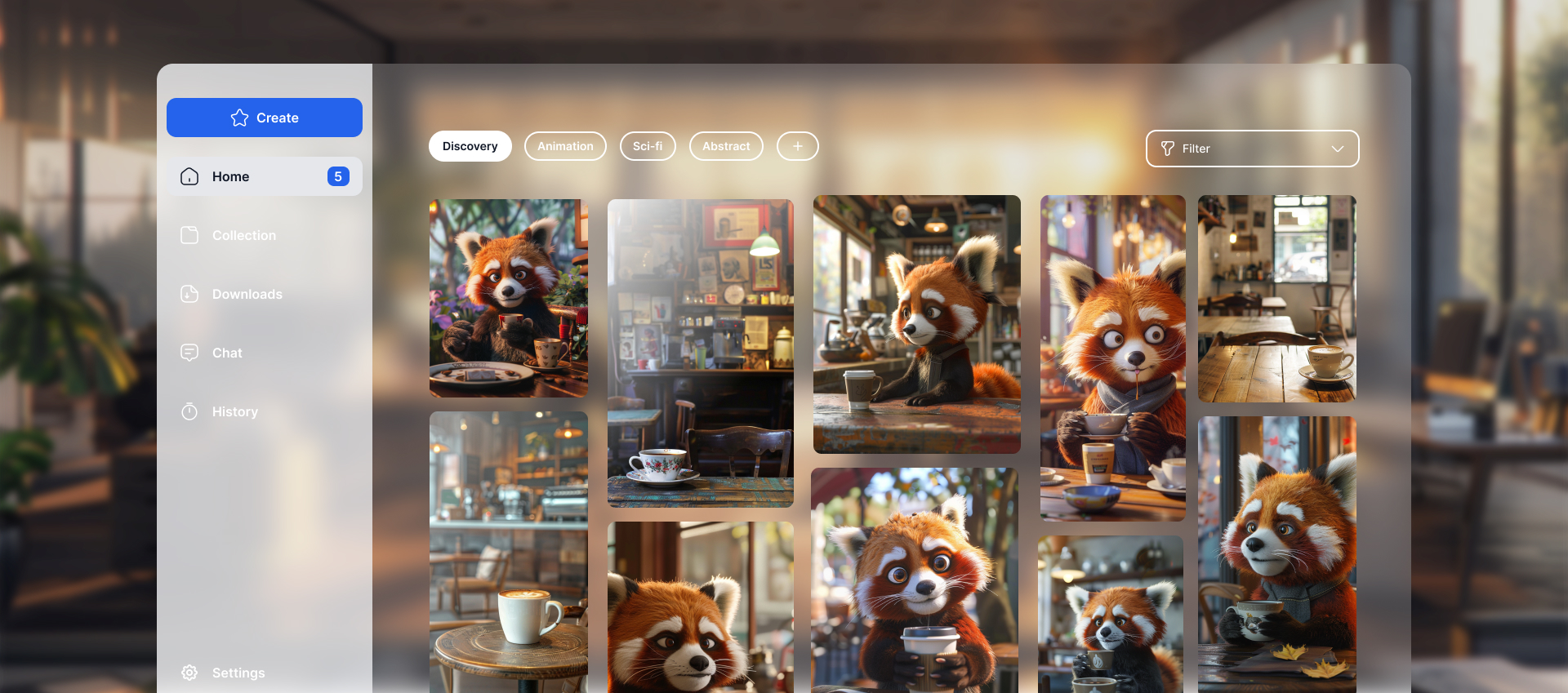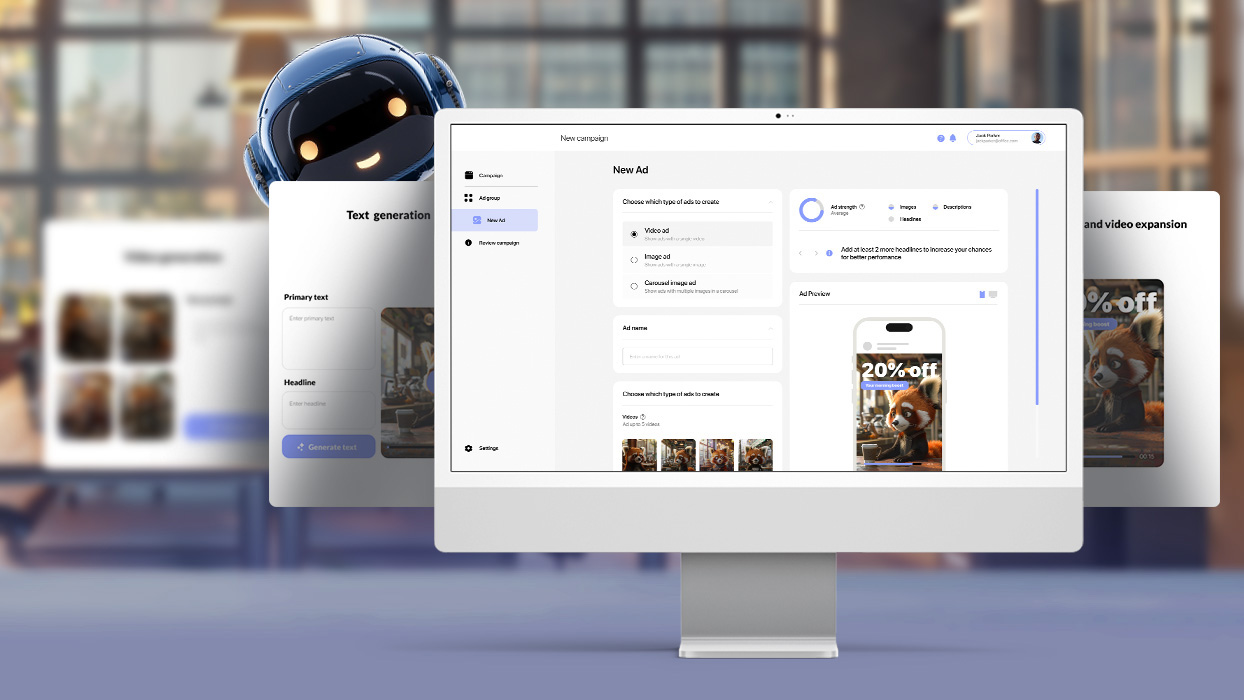Why do AI video ads turn from a nice-to-have to a must-have solution?
It’s the dawn of 2022, and the generative AI tools spark curiosity by offering designers inspiration through clumsy, half-baked images akin to napkin sketches.
Zoom ahead to 2024, and text-to-video systems are fully generating narrative-driven videos with the feel of the physical world texture, promising sleek creatives without the usual resource investment of traditional video production.
Couple them with the analytical AIs capable of real-time audience-specific adjustments and predictive precision — and it seems that modern advertising is on the verge of running on AI.
Which, in fact, isn’t far from reality. Though with significant nuances.
That’s where this article comes in. Over the next five minutes, experts from two sides of the AdTech world will break down all the nuances and facets of building a well-defined AI strategy in advertising and effectively integrating AI video ads.
Artificial Intelligence Specialist
Alexey Karankevich
AdTech Business Solution Architect
Kyrylo Stegnii
In what ways can AI video ads complement businesses?
Two main camps stand to greatly benefit (read: gain or at least save money) from using AI to create video ads: advertisers and ad networks or AdTech software vendors.
What’s in there for advertisers?
If an advertiser lacks a substantial library of video creatives and doesn’t have the in-house resources to quickly generate new variations, AI can fill the gap by offering fresh takes on existing content or creating entirely new material based on specific parameters. This capability saves time and resources, leading to a higher ROI and enabling ad placements in areas previously unaffordable due to video production expenses.
Moreover, by integrating automatic video generation into other processes like campaign analytics, advertisers can optimize their creative workflows, allowing for the automatic generation or regeneration of creatives based on campaign performance data. For businesses looking to harness the full potential of these advanced technologies, partnering with a Generative AI consulting firm can provide the expertise needed to implement and optimize AI-driven solutions effectively, ensuring a competitive edge in the dynamic advertising landscape.
How can ad networks and AdTech vendors capitalize on this?
For ad networks, AI video production can be a key feature that attracts a broader range of advertisers and helps them stand out from competitors by adding significant value for their clients.
Moreover, AI video advertising can optimize production costs by automating repetitive tasks and streamlining workflows, enabling ad networks to offer more competitive pricing.
For AdTech vendors, AI-powered creative tools present a major opportunity to enhance their platforms and reach a wider customer base by empowering advertisers with advanced tools for creative optimization and campaign management.

Where to start from in case you need to create an AI-powered advertising tool?
Since execution eats strategy for breakfast, let’s immediately consider a real-life example of one of our clients to see how, in practice, a comprehensive AI-driven solution for launching ad campaigns, complete with AI-generated video creatives, works from start to finish.
The process begins with a tool that takes URLs (websites) as input, extracts, creates, and categorizes assets from these URLs, and then generates creatives from these assets.
Next, these creatives get uploaded into an ad placement system via an API, where they are executed. Data is collected from the analytics system, and the process repeats.
Since buying the right advertising space is key in the bidding system, it’s crucial to have a feedback loop between the analyzed data and the creative generation tool, which crafts varied and relevant text prompts based on specific themes.
And, finally, getting the best results means understanding how the model responds to these prompts and what it churns out. That’s where fine-tuning comes in — tweaking and optimizing the model’s settings to keep everything running smoothly and efficiently.
Win bigger with AI actor innovation
A new star of video advertising is born. Or, better put, algorithmically crafted. AI actors are a cost-effective alternative to live actors, enabling globally adaptable ad campaigns that overcome cultural and linguistic barriers and allowing for using voice synthesis in any scenario.
And no disrespect for the legal and ethical considerations, like the need to keep AI actors anonymous and avoid mimicking known personalities, but even with these caveats, those delving into AI actor development can expect strong support and profit.
So what does it take to weave such a tool into your advertising while addressing privacy concerns? We could keep talking about it, but why not let us show you?
What tools do you need and what to watch out for when using them?
For those speed-scrolling through, the short answer is that most of the time, an off-the-shelf solution for generating creative content, which can be customized and configured to tackle specific tasks and meet a company’s unique needs, will suffice. With some preliminary data processing that the model will work with later, you’re good to go.
But for those hungry for the nitty-gritty, let’s get into it. Picture this: A company wants to generate video ads with AI based on a prompt but doesn’t want to shell out for creatives. They want to automate the process with clear, understandable, and non-abstract hypotheses incorporated into the prompt. In this scenario, a robust solution involves using an AI model like Sora.
The best way to use Sora is as an agent in an automated video generation pipeline. You can feed it various hypotheses, each with different prompts, and Sora will generate content in parallel, delivering results to a designated location. Later, you can set up metrics to track the success of these creatives and gather all this data into a report using a BI tool.
While this process won’t be real-time, you’ll get system outputs with a slight delay. You’ll have different creatives, feedback on them, and a dashboard to monitor this feedback, allowing you to react accordingly. Ideally, this takes the pain out of the long and arduous task of designing creatives manually.
Next up is polishing the creatives that performed well: adjusting text size, experimenting with various colors, playing with object placement and focus, etc.
However, there’s a crucial point that casts a faint shadow on the idea of complete process automation — while AI, using prompts, can handle fine-tuning creatives based on received data, there are moments when a human touch and a bit of manual intervention might still be necessary.
At the same time, even though these solutions already have several useful features, there might still be a need to expand their functionality, configure proper dataset handling, retrain the model, or even orchestrate different models to maximize benefit — which, of course, requires additional adjustments.

What’s the winning formula for maximizing the potential of AI tools?
Oxagile’s AI project expertise shouts it loud and clear: Implementing one or both of the following key strategies is what guarantees the right results for campaign optimization with artificial intelligence:
- Orchestrating multiple AI models
Combining AI models tailored for different tasks can significantly enhance overall performance. For instance, you might use one model to create video ads with AI and another for SEO optimization. Integrating these models using advanced engineering knowledge, including skills in MLOps and DevOps, allows for the creation of a robust ensemble that will be targeting multiple objectives, thereby increasing efficiency and effectiveness. - Fine-tuning AI models
Fine-tuning models with specific user data and audience segmentation can lead to the automatic generation of highly tailored creatives, which can significantly boost engagement. By leveraging historical data, you can predict which types of content will resonate most with different segments of your audience. Techniques such as self-attention mechanisms from large language models can be particularly useful in refining this predictive capability, ensuring that the content is both relevant and appealing to the target audience.
Case in point: Optimizing ad creatives with AI and prompt engineering
Oxagile teamed up with a creative marketing agency to streamline and automate their ad creation processes, specifically leveraging prompt engineering and model orchestration that combined the capabilities of LangChain and CrewAI. Here’s how their automated ad creative pipeline works now:
- Input handling: Marketing managers provide campaign goals and audience details.
- Prompt generation: Tailored prompts are created to guide the AI models.
- Content generation: LangChain handles a range of language model tasks and manages the initial content drafts and idea generation.
- Refinement: CrewAI coordinates multiple AI agents, each specializing in different aspects of ad creation, such as copywriting, visual design, and performance analytics, to refine these drafts, improving text, visuals, and overall appeal.
- Iteration: The system incorporates A/B testing feedback to fine-tune the creatives, maximizing engagement and performance.
This AI-driven solution has greatly improved efficiency, cutting down the time needed to produce ad creatives, reducing the need for a large creative team, and consistently delivering high-quality ad content.

What are the next AI moves in the advertising industry?
We trust that most of you reading this already grasp — or at least have a gut feeling — that there’s a wealth of practical ways to infuse AI into AdTech, extending far beyond just video creatives. We’re talking about everything from purchasing and contextual targeting to conversational AI, audience segmentation, traffic management, video distribution, and more.
And if the question on your mind right now is: “Can AI work out in my case and give my business an extra edge over the competition?” — our AdTech expert team are set out to offer more than the textbook answers and demonstrate how AI works in real business scenarios or sketch out a roadmap of how AI can work its magic to achieve your specific objectives.



























